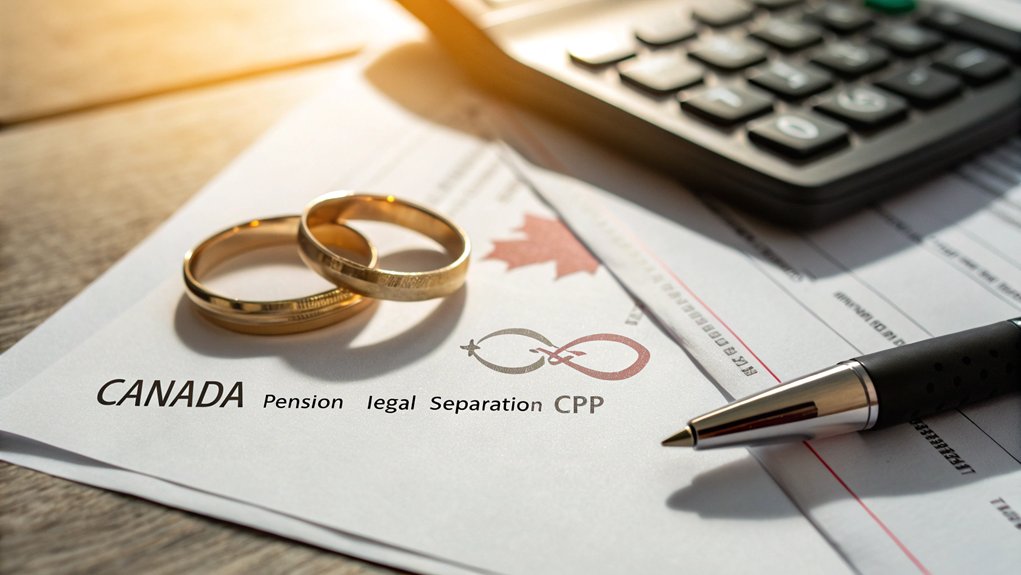Can Canada Pension Plan Credits Be Split After Divorce or Separation?
Former spouses can force CPP credit splits without consent—but some provinces let you escape this automatic division. Learn which protections exist.
Yes, Canada Pension Plan credits can be split between former spouses after divorce or separation through a federally recognized legal process. This equitable distribution pools pensionable earnings accumulated during the relationship, dividing them equally between partners who cohabited for at least 12 continuous months. Either spouse can initiate the process without consent, though certain provinces allow opt-out agreements. Understanding the specific eligibility requirements, documentation needs, and potential financial impacts will help determine the best approach for individual circumstances.

When couples face the challenging circumstances of divorce or separation, understanding whether Canada Pension Plan credits can be divided between former spouses becomes a critical financial consideration that directly impacts retirement security. The answer is definitively yes, as CPP credit splitting represents a recognized legal process designed to guarantee equitable distribution of pension assets accumulated during relationships, providing protection for both married and common-law partnerships that have ended.
CPP credit splitting ensures equitable distribution of pension assets for divorced or separated couples, protecting both married and common-law partnerships.
The fundamental mechanics of CPP credit splitting involve pooling all pensionable earnings that both spouses accumulated during their time together, then dividing these credits equally between the parties. This calculation encompasses all eligible years up to the year preceding separation, meaning couples who separated in 2020 would have credits split through 2019. The process recognizes that one spouse may have earned substantially less due to child-rearing responsibilities, household duties, or career sacrifices made for family benefit.
Eligibility requirements mandate that couples must have cohabitated for at least twelve continuous months, with separations occurring after January 1, 1987, qualifying for most credit splitting applications. Either spouse can initiate the process through Service Canada without requiring consent from the other party, unless specific opt-out agreements exist. Required documentation includes marriage certificates, divorce decrees, separation agreements, and proof of common-law status where applicable. Common-law couples must complete their applications within 48 months of separation to maintain eligibility for credit splitting.
Importantly, no time constraints exist for credit splitting applications, except when one spouse dies, which triggers a thirty-six-month deadline for surviving partners. However, certain provinces including British Columbia, Alberta, Saskatchewan, and Quebec permit couples to opt out of automatic splitting under specific conditions, and agreements predating June 4, 1986, may prevent splitting altogether. Credit splitting is prohibited when the couple’s total pensionable earnings fall below 2x basic exemption amounts, ensuring only meaningful benefit distributions are processed. It’s essential to maintain proper beneficiary designation on retirement accounts throughout the separation process to ensure benefits transfer as intended.
The financial impact varies extensively based on relative earnings during the relationship, potentially increasing benefits for lower-earning spouses while reducing them for higher earners. While credit splitting may decrease overall pension value in some cases, particularly where child-rearing dropout provisions affect calculations, the process fundamentally guarantees fairness in retirement income distribution. Professional financial consultation proves invaluable before making splitting decisions, as the long-term ramifications require careful analysis of individual circumstances and potential benefit adjustments.
Frequently Asked Questions
How Long Does the CPP Credit Splitting Process Take to Complete?
CPP credit splitting processing typically requires several weeks to a few months for completion, depending on Service Canada’s current workload and application completeness.
Complex marital histories, missing documentation, or incomplete forms commonly extend timeframes, while straightforward cases with proper paperwork process more efficiently.
Both parties receive updated pension statements reflecting new credit balances once Service Canada verifies eligibility, contribution periods, and finalizes the permanent split.
Can I Apply for CPP Credit Splitting if My Ex-Spouse Lives Abroad?
Yes, an individual can apply for CPP credit splitting even when their ex-spouse lives abroad. Service Canada processes applications regardless of the former partner’s international residence, requiring only standard documentation including marriage certificates, divorce or separation orders, and relevant agreements.
The ex-spouse’s foreign location does not prevent, delay, or invalidate the credit splitting application or processing timeline.
What Happens to CPP Credits if We Remarry the Same Person?
Remarriage to the same person does not automatically reverse or affect previously completed CPP credit splitting from the original separation or divorce. The earlier credit split remains permanent and binding, covering only the initial relationship period.
New CPP credits accumulated during the remarriage are treated separately and independently from the previously split credits, creating distinct pension entitlements for each cohabitation period.
Are There Any Fees Associated With Applying for CPP Credit Splitting?
Service Canada imposes no application fees for CPP credit splitting, since this represents a government benefit adjustment rather than a fee-based service.
While the official application process through Service Canada remains cost-free, individuals may incur separate expenses for legal or financial advisory services when seeking professional guidance to navigate complex situations or resolve disputes during the credit splitting process.
Can CPP Credit Splitting Be Reversed After It’s Been Processed?
CPP credit splitting can be reversed only within a narrow 60-day window after receiving approval notification from Service Canada, allowing applicants to withdraw their request and effectively reverse the split.
Once this withdrawal period expires, the credit split becomes permanently final and cannot be reversed through any administrative process, particularly after retirement benefits commence based on the split credits.
What’s next?
The information provided is based on current laws, regulations and other rules applicable to Canadian residents. It is accurate to the best of our knowledge as of the date of publication. Rules and their interpretation may change, affecting the accuracy of the information. The information provided is general in nature, and should not be relied upon as a substitute for advice in any specific situation. For specific situations, advice should be obtained from the appropriate legal, accounting, tax or other professional advisors. Full details of coverage, including limitations and exclusions that apply, are set out in the certificate of insurance provided on enrollment.
This article is meant to provide general information only. It’s not professional medical advice, or a substitute for that advice.
Saphira Financial Group does not provide legal, accounting, taxation, or other professional advice. Please seek advice from a qualified professional, including a thorough examination of your specific legal, accounting and tax situation.







